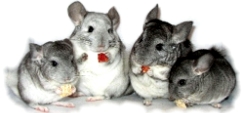That's moving pretty fast for a new chinchilla. Sounds like yours will be easy to tame. Make sure that for the first two weeks handling him is his idea or it will make it more difficult to tame him later on cause he might start acting up. This has been my observation with other people on this board who are new chin owners.
With chinchillas sometimes it's pretty hard to tell if they are sick. One thing that can help is to weigh your chinchilla on a gram scale a couple of times a week. Usually chins are pretty stressed the first two weeks after relocation so it's hard to get a good base line. If you see a consistent trend of weight loss then you know something is up. The trick is to weigh your chinchilla without causing it stress. It may be wise to wait a few weeks before attempting this. One thing you can do is put him in a box (calibrate the scale with the empty box on it) then put him on the scale.
Another good indicator is to watch the droppings. Again you need a baseline. Look for hardness, volume, and color. If the droppings get softer and larger or become green in appearance this indicates a failure to digest things all the way. Sometimes it can be an indicator of stress but if it doesn't resolve itself in a day or so it can be an indicator of infection.
If they become smaller and there are less of them this indicates constipation. If they are larger and looser this can be a precursor to diarrhea. If liquid this is a medical emergency for a chinchilla and they can die within hours if it's bad enough. On the other hand if there a marked decrease and there are very few in a day this is a different emergency. Bloat often occurs with constipation and is sometimes fatal if not managed. Another complication with severe constipation is sometime rectal prolapse which can sometimes cause fatal complications.
Drooling is another bad sign. Usually this presents with wet fur under the chin and down the front of the animal. Often it smells like an infection. This can be caused by tooth problems that will need to be diagnosed by a vet. Sometimes it's because of fungal contamination of food which can be deadly. Always keep track of the freshness of food and hay. If it looks or smells off or is damp don't feed it.
Another thing to watch for is how much food is consumed in a day. This is not always reliable because it's hard to tell with hay. Chins are known for playing with it and scattering it. Chinchillas eat more hay than pellets and not always in the same ratio but eventually you'll get a feel for how much pelleted diet is consumed in a day. If your chinchilla is crumbling the pellets instead of eating them this is usually a sign of tooth problems that should be checked out. Tooth problems can be fatal if untreated.
Water levels are another good thing to watch. Chins consume about the same amount of water per day but disease process can effect its intake. Also make sure your water bottle is set up so it's not leaking and provides an accurate measure.
Common diseases are eye infections which cause the eyes to water. Often there is white mucous or pus near or on the eye. If the eye ever gets stuck shut it must be reopened to prevent damage to the eyeball. Fur fungus usually starts out as patches of missing fur around the nose or base of the ears. Where the fur is missing the skin underneath appears irritated and scaly, unlike what you see in fur slip, where the skin looks normal. Sometimes dry skin can look like fungus but the way to tell is that fungus spreads. Fungus is curable if the right steps are taken to treat it but it's also (usually) contagious even to people.
Respiratory infections sometimes present with drainage at the nose and eyes but not always. It does effect breathing and may present with noisy breath sounds and hoarseness. Sometimes you don't catch it until you notice depression sometimes accompanied by mucous laden feces. If you suspect a respiratory infection it's probably best to see a vet as these are very dangerous and can progress quickly. They are often highly contagious to other chinchillas and possibly other pets.
Change in activity and depression usually doesn't happen until things are really bad and sometimes too far gone to effectively treat the underlying problem whatever it might be. Prey animals hide sickness and disease until they are unable to as an instinct.
Medications such as antibiotics are also dangerous and additional care should be taken to ensure the animal keeps eating regularly (even if it means hand feeding) to prevent GI status which is fatal if left untreated.
Other than that being observant of how your chinchilla normally behaves, how he eats food, drinks water, how often, how much, how much droppings are produced in day, etc. is key to early detection.

 Author
Topic: Introducing a Chinchilla to turtles (Read 1920 times)
Author
Topic: Introducing a Chinchilla to turtles (Read 1920 times)




